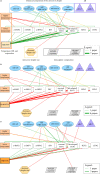Review of factors affecting virus inactivation in aerosols and droplets
- PMID: 38920060
- PMCID: PMC11285516
- DOI: 10.1098/rsif.2024.0018
Review of factors affecting virus inactivation in aerosols and droplets
Abstract
The inactivation of viruses in aerosol particles (aerosols) and droplets depends on many factors, but the precise mechanisms of inactivation are not known. The system involves complex physical and biochemical interactions. We reviewed the literature to establish current knowledge about these mechanisms and identify knowledge gaps. We identified 168 relevant papers and grouped results by the following factors: virus type and structure, aerosol or droplet size, temperature, relative humidity (RH) and evaporation, chemical composition of the aerosol or droplet, pH and atmospheric composition. These factors influence the dynamic microenvironment surrounding a virion and thus may affect its inactivation. Results indicate that viruses experience biphasic decay as the carrier aerosols or droplets undergo evaporation and equilibrate with the surrounding air, and their final physical state (liquid, semi-solid or solid) depends on RH. Virus stability, RH and temperature are interrelated, but the effects of RH are multifaceted and still not completely understood. Studies on the impact of pH and atmospheric composition on virus stability have raised new questions that require further exploration. The frequent practice of studying virus inactivation in large droplets and culture media may limit our understanding of inactivation mechanisms that are relevant for transmission, so we encourage the use of particles of physiologically relevant size and composition in future research.
Keywords: aerosol; droplet; humidity; inactivation; virus.
Conflict of interest statement
We declare we have no competing interests.
Figures



![Schematic of potential changes in pH in aerosols and droplets after exhalation into ambient air [10,55,65].](https://cdn.ncbi.nlm.nih.gov/pmc/blobs/ec49/11285516/7a27e2cfa387/rsif.2024.0018.f004.gif)
References
-
- Riley RL. 1982. Indoor airborne infection. Environ. Int. 8 , 317–320. ( 10.1016/0160-4120(82)90043-5) - DOI
Publication types
MeSH terms
Substances
Grants and funding
LinkOut - more resources
Full Text Sources

